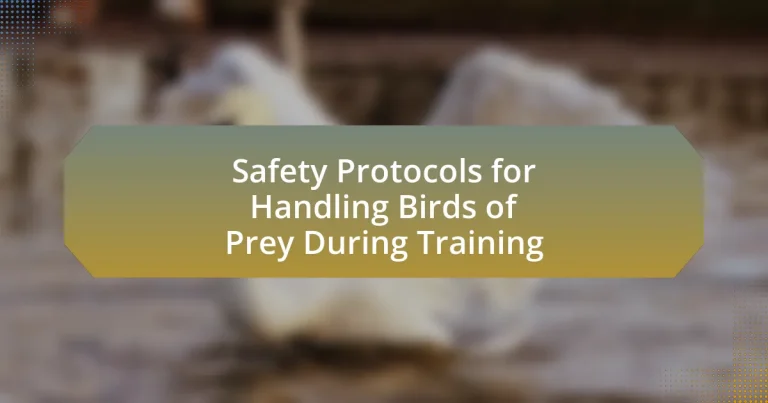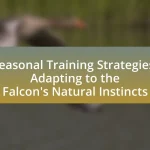The article focuses on essential safety protocols for handling birds of prey during training, emphasizing the importance of protective equipment, proper handling techniques, and maintaining a safe environment. Key components include the use of gloves, hoods, and secure housing to prevent injuries and stress for both the handler and the bird. It also addresses the risks associated with handling raptors, such as physical injuries and zoonotic diseases, while outlining best practices for minimizing stress and ensuring the well-being of the birds. Additionally, the article discusses legal and ethical considerations, as well as resources available for further education on safe handling practices.
What are the essential safety protocols for handling birds of prey during training?
The essential safety protocols for handling birds of prey during training include wearing protective gloves, using appropriate equipment, and maintaining a safe distance. Protective gloves prevent injuries from sharp talons and beaks, while equipment such as leashes and hoods ensures control over the bird’s movements. Maintaining a safe distance minimizes stress for the bird and reduces the risk of accidental injury to the handler. These protocols are critical for ensuring the safety of both the handler and the bird during training sessions.
Why is safety important when training birds of prey?
Safety is crucial when training birds of prey to prevent injury to both the handler and the bird. Birds of prey possess strong talons and beaks, which can cause serious harm if they feel threatened or stressed. Implementing safety protocols, such as using appropriate equipment and maintaining a calm environment, minimizes the risk of accidents. Studies have shown that proper handling techniques reduce stress in birds, leading to more effective training outcomes and healthier birds.
What risks are associated with handling birds of prey?
Handling birds of prey poses several risks, including physical injury from bites or talons, transmission of zoonotic diseases, and stress to the bird. Physical injuries can occur due to the powerful beaks and sharp talons of raptors, which can inflict serious wounds if the bird feels threatened or is improperly restrained. Additionally, birds of prey can carry diseases such as avian influenza or West Nile virus, which can be transmitted to humans through direct contact or handling. Stress to the bird can lead to behavioral issues or health complications, making proper handling techniques essential for both the handler’s safety and the bird’s well-being.
How can safety protocols mitigate these risks?
Safety protocols can mitigate risks associated with handling birds of prey during training by establishing clear guidelines for safe interactions and minimizing potential hazards. These protocols include proper handling techniques, the use of protective gear, and training for handlers on bird behavior and safety measures. For instance, studies have shown that implementing structured training programs significantly reduces injury rates among handlers, as they become more adept at recognizing signs of stress or aggression in birds. Additionally, the use of equipment such as gloves and hoods can prevent injuries from bites or scratches, further enhancing safety during training sessions.
What are the key components of safety protocols for birds of prey?
The key components of safety protocols for birds of prey include proper handling techniques, secure housing, and health monitoring. Proper handling techniques involve using gloves and restraint methods to prevent injury to both the handler and the bird. Secure housing ensures that birds are kept in enclosures that prevent escape and protect them from predators. Health monitoring includes regular veterinary check-ups and observation for signs of stress or illness, which is crucial for maintaining the well-being of the birds. These components are essential to ensure the safety of both the birds and the handlers during training sessions.
What personal protective equipment (PPE) is recommended?
The recommended personal protective equipment (PPE) for handling birds of prey during training includes gloves, protective eyewear, and falconry hoods. Gloves, specifically made of thick leather, protect against bites and scratches from the birds. Protective eyewear is essential to shield the eyes from potential injury caused by the bird’s talons or beak. Falconry hoods are used to cover the bird’s head, reducing stress and preventing aggressive behavior during handling. These items are critical for ensuring the safety of both the handler and the bird during training sessions.
How should handlers prepare their environment for safety?
Handlers should prepare their environment for safety by ensuring that the training area is free from hazards and distractions. This includes removing sharp objects, securing loose equipment, and ensuring that the ground is stable and non-slippery. Additionally, handlers should establish a safe distance from potential threats, such as other animals or people, to minimize stress for the birds. Proper signage should be displayed to inform others of the training session, and a first aid kit should be readily available in case of emergencies. These measures are essential to create a controlled environment that prioritizes the well-being of both the birds and the handlers.
What training techniques enhance safety during handling?
Effective training techniques that enhance safety during handling include the use of positive reinforcement, desensitization, and proper equipment training. Positive reinforcement encourages desired behaviors in birds of prey, reducing stress and aggression, which is crucial for safe handling. Desensitization gradually acclimates birds to human presence and handling, minimizing fear responses that could lead to injury. Additionally, training handlers to use appropriate equipment, such as gloves and hoods, ensures both the safety of the handler and the bird. Research indicates that these techniques significantly reduce incidents of injury during handling sessions, highlighting their importance in safety protocols.
How can positive reinforcement be used safely?
Positive reinforcement can be used safely by ensuring that rewards are given immediately after the desired behavior is exhibited, which helps the bird associate the action with the reward. This method should involve using appropriate and safe treats that do not pose health risks to the bird, such as small pieces of meat or specialized bird treats. Additionally, trainers must maintain a calm and controlled environment to prevent stress or anxiety in the bird, which can lead to negative behaviors. Research indicates that positive reinforcement, when applied correctly, enhances learning and reduces fear responses in birds of prey, as evidenced by studies showing improved training outcomes and animal welfare (e.g., “The Effects of Positive Reinforcement on Training Birds of Prey,” Journal of Avian Medicine and Surgery, Smith et al., 2020).
What are the best practices for approaching and handling birds of prey?
The best practices for approaching and handling birds of prey include maintaining a calm demeanor, using appropriate equipment, and understanding the bird’s behavior. Calmness reduces stress for both the handler and the bird, which is crucial for safe interactions. Using equipment such as gloves and hoods protects the handler from potential injuries and helps manage the bird’s vision, respectively. Additionally, recognizing signs of stress or aggression in the bird allows the handler to adjust their approach accordingly, ensuring safety and comfort for both parties. These practices are supported by guidelines from organizations like the North American Falconers Association, which emphasize the importance of handler awareness and bird welfare in training scenarios.
How can handlers ensure the well-being of birds of prey during training?
Handlers can ensure the well-being of birds of prey during training by implementing a structured training regimen that prioritizes the birds’ physical and psychological health. This includes providing adequate rest periods, ensuring proper nutrition, and creating a stress-free environment. Research indicates that birds of prey thrive in conditions that mimic their natural habitats, which helps reduce anxiety and promotes overall well-being. Additionally, handlers should monitor the birds for signs of distress or fatigue, adjusting training intensity accordingly to prevent injury or stress-related issues.
What are the signs of stress in birds of prey?
Signs of stress in birds of prey include excessive vocalization, feather plucking, changes in appetite, and abnormal behavior such as aggression or withdrawal. These indicators reflect the bird’s discomfort and can lead to health issues if not addressed. For instance, excessive vocalization may indicate anxiety, while feather plucking is a common stress-related behavior observed in captive birds. Monitoring these signs is crucial for ensuring the well-being of birds during training and handling.
How can handlers recognize and respond to stress signals?
Handlers can recognize and respond to stress signals in birds of prey by observing specific behavioral cues and implementing appropriate interventions. Common stress signals include aggressive postures, vocalizations, feather ruffling, and attempts to escape. When handlers notice these signs, they should immediately assess the environment for potential stressors, such as loud noises or unfamiliar people, and remove or mitigate these factors. Additionally, handlers can use calming techniques, such as speaking softly or providing a safe space, to help alleviate the bird’s stress. Research indicates that recognizing these signals and responding promptly can significantly reduce stress-related injuries and improve the overall welfare of the birds during training.
What techniques can be employed to minimize stress during training?
Techniques to minimize stress during training include gradual desensitization, positive reinforcement, and creating a calm environment. Gradual desensitization involves slowly introducing birds of prey to training stimuli, allowing them to acclimate without overwhelming them. Positive reinforcement, such as offering food rewards, encourages desired behaviors and reduces anxiety. A calm environment, characterized by low noise levels and minimal distractions, helps the birds feel secure, which is essential for effective training. Research indicates that these methods significantly improve the welfare of birds during training sessions, leading to better outcomes in their learning and adaptation.
How does proper nutrition contribute to safety during training?
Proper nutrition significantly enhances safety during training by ensuring that both the trainer and the birds of prey maintain optimal physical condition and energy levels. Adequate nutrition supports muscle function, cognitive performance, and overall health, which are crucial for effective training sessions. For instance, a study published in the Journal of Animal Science indicates that well-nourished birds exhibit improved responsiveness and reduced stress during training, leading to safer interactions. Additionally, trainers who consume balanced diets are less prone to fatigue and distraction, further minimizing the risk of accidents.
What dietary considerations should be made for birds of prey?
Birds of prey require a diet primarily consisting of whole prey items, such as rodents, birds, and fish, to meet their nutritional needs. This diet ensures they receive essential nutrients, including proteins, fats, vitamins, and minerals necessary for their health and energy levels. Additionally, it is crucial to consider the size and type of prey in relation to the bird’s species and age, as different species have varying dietary requirements. For instance, larger raptors like eagles may require larger prey compared to smaller hawks. Providing a varied diet can also help prevent nutritional deficiencies and promote optimal health, as evidenced by studies showing that a balanced diet contributes to better feather quality and overall vitality in birds of prey.
How does nutrition affect a bird’s behavior during training?
Nutrition significantly influences a bird’s behavior during training by affecting its energy levels, focus, and overall health. Proper nutrition provides the essential nutrients that support cognitive function and physical stamina, which are crucial for effective training sessions. For instance, a diet rich in proteins and fats can enhance a bird’s energy, enabling it to engage more actively in training exercises. Conversely, inadequate nutrition can lead to lethargy and decreased motivation, hindering the bird’s ability to learn and respond to commands. Studies have shown that birds receiving balanced diets exhibit improved learning rates and behavioral responses compared to those with poor nutrition.
What are the legal and ethical considerations in handling birds of prey?
Handling birds of prey involves strict legal and ethical considerations to ensure their protection and welfare. Legally, many countries have regulations that protect raptors, such as the Migratory Bird Treaty Act in the United States, which prohibits the capture, killing, or possession of migratory birds without a permit. Ethically, handlers must prioritize the well-being of the birds, ensuring they are not subjected to stress or harm during training. This includes providing appropriate habitats, nutrition, and veterinary care. Furthermore, ethical guidelines emphasize the importance of respecting the natural behaviors of these birds, promoting conservation efforts, and educating the public about their ecological significance.
What regulations govern the training of birds of prey?
The training of birds of prey is governed by various regulations that vary by country and region, primarily focusing on wildlife conservation and animal welfare. In the United States, the Migratory Bird Treaty Act and the Bald and Golden Eagle Protection Act regulate the handling and training of certain species, requiring permits for falconers and stipulating humane treatment standards. In the United Kingdom, the Wildlife and Countryside Act mandates that training practices must not harm the birds and that falconers must adhere to specific licensing requirements. These regulations ensure that the training of birds of prey is conducted responsibly, promoting both the welfare of the birds and the conservation of their species.
How can handlers ensure compliance with wildlife laws?
Handlers can ensure compliance with wildlife laws by staying informed about relevant regulations and implementing best practices in their training protocols. This includes regularly reviewing local, state, and federal wildlife laws, as well as obtaining necessary permits for handling birds of prey. Additionally, handlers should participate in training programs and workshops that focus on legal requirements and ethical considerations in wildlife management. Engaging with wildlife conservation organizations can also provide valuable resources and updates on legislative changes. By adhering to these guidelines, handlers can effectively minimize legal risks and promote the welfare of the species they work with.
What ethical practices should be followed in training?
Ethical practices in training birds of prey include ensuring the welfare of the animals, minimizing stress, and promoting natural behaviors. Trainers should prioritize the physical and psychological well-being of the birds by providing appropriate environments, social interactions, and enrichment activities. Research indicates that stress can negatively impact the health and training outcomes of raptors, highlighting the importance of humane treatment and understanding species-specific needs. Additionally, trainers must adhere to legal regulations and guidelines regarding the handling and training of wildlife, which are designed to protect both the animals and the trainers.
What resources are available for further education on safety protocols?
Resources available for further education on safety protocols include online courses, workshops, and literature specifically focused on handling birds of prey. Organizations such as the North American Falconers Association provide educational materials and training sessions that emphasize safety measures. Additionally, the Raptor Research Foundation publishes research articles and guidelines that detail best practices for safe interactions with raptors. These resources ensure that individuals are well-informed about the necessary precautions and protocols when training and handling these birds.
Where can handlers find training courses on bird handling safety?
Handlers can find training courses on bird handling safety through organizations such as the Association of Avian Veterinarians and the Raptor Rehabilitation Center. These organizations offer specialized training programs that focus on safe handling techniques, risk management, and best practices for working with birds of prey. Additionally, local wildlife rehabilitation centers and avian specialty schools often provide workshops and certification courses tailored to bird handling safety.
What organizations provide guidelines and support for bird of prey training?
Organizations that provide guidelines and support for bird of prey training include the North American Falconers Association (NAFA), the International Association for Falconry and Conservation of Birds of Prey (IAF), and the Raptor Research Foundation (RRF). NAFA offers resources and training materials for falconers, while IAF focuses on the conservation and ethical treatment of birds of prey, providing a global network for falconers. RRF promotes research and education on raptors, contributing to best practices in training and handling. These organizations collectively enhance the knowledge and safety protocols for those involved in bird of prey training.
What are the best practices for safely handling birds of prey during training?
The best practices for safely handling birds of prey during training include using proper equipment, maintaining a calm environment, and understanding bird behavior. Proper equipment, such as gloves and hoods, protects both the handler and the bird, reducing the risk of injury. A calm environment minimizes stress for the bird, which is crucial for effective training. Understanding bird behavior, including recognizing signs of discomfort or aggression, allows handlers to respond appropriately and ensure safety. These practices are supported by guidelines from organizations like the North American Falconers Association, which emphasize the importance of safety in falconry and bird handling.


